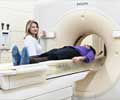In a group of 10,000 young people, the researchers say that they would expect 39 cancers to occur during the next 10 years, but if they all had one CT scan, up to six extra cancers would occur.

There is currently much uncertainty and as such, researchers from Australia and Europe carried out a study comparing cancer rates in patients exposed to CT scans at ages 0-19 years compared with unexposed persons of a similar age. All participants were born between 1985 and 2005 with total follow-up ending at the end of 2007. This is the largest ever population-based study of medical radiation exposure.
Data were taken from Australian Medicare records and from national cancer records. The main outcome of the research was to identify cancer rates in individuals exposed to a CT scan more than one year before any cancer diagnosis. Mean length of follow-up was 9.5 years for the exposed group and 17.3 for the unexposed group.
The cohort included 10.9 million people, 680,211 of whom were CT-exposed at least 12 months before any cancer diagnosis. 18% of these had more than one scan.
By the end of 2007, 3150 of the exposed group and 57,524 of the unexposed group had been diagnosed with cancer. The incidence rate was 24% greater in the exposed group after adjusting for age, sex and year of birth. Risk increased by 16% for each additional CT scan.
For brain cancer, although the incidence in the exposed group declined with time since first CT-exposure, brain cancer incidence was still significantly increased more than 15 years after first exposure. For other solid cancers (tumours as opposed to cancers of the blood or bone marrow) the absolute excess cancer incidence increased significantly with time since first exposure.
Advertisement
For brain cancer, the highest risk was seen in children exposed before the age of five years and this risk decreased with increasing age at first exposure. However, despite this decrease, risk for all cancers combined remained significantly increased in the oldest age at exposure group (15-19 years).
Advertisement
The researchers say that almost 60% of CT scans were of the brain and recognise that "in some cases the brain cancer may have led to the scan rather than vice versa". They add that they "cannot assume that all the excess cancers […] were caused by CT scans" and they "cannot rule out the possibility of some reverse causation, particularly for some cases of brain cancer".
Nevertheless, they conclude that the "increased incidence of many different types of cancer […] is mostly due to irradiation". They point out that because the cancer excess was still continuing at the end of follow-up, the "eventual lifetime risk from CT scans cannot yet be determined". They recommend that practitioners will need to weigh the benefits against the potential risks to justify each CT scan decision.
In an accompanying editorial, Dr Sodickson from Harvard Medical School says it is important to recognise that the incidence of cancer in children is extremely small and so "a 24% increase makes this risk just slightly less small". He says that there are many methods to manage radiation dose and with further validation of risk models, "more accurate risk assessment "can be performed to "better inform imaging decisions".
Source-Eurekalert















